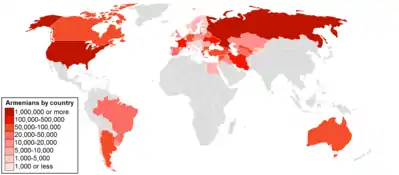Armenians in Hungary
Armenians in Hungary (Hungarian: Örmények) are ethnic Armenians living in modern Hungary.
| Total population | |
|---|---|
| 3,500,[1] 6,000,[2] 15,000,[3] 30,000[4] | |
| Regions with significant populations | |
| Languages | |
| Armenian, Hungarian | |
| Religion | |
| Armenian Apostolic, Armenian Catholic |
| Part of a series on |
| Armenians |
|---|
 |
| Armenian culture |
|
Architecture · Art Cuisine · Dance · Dress Literature · Music · History |
| By country or region |
|
Armenia · Artsakh See also Nagorno-Karabakh Armenian diaspora Russia · France · India United States · Iran · Georgia Azerbaijan · Argentina · Brazil Lebanon · Syria · Ukraine Poland · Canada · Australia Turkey · Greece · Cyprus Egypt · Singapore · Bangladesh · China |
| Subgroups |
| Hamshenis · Cherkesogai · Armeno-Tats · Lom people · Hayhurum |
| Religion |
|
Armenian Apostolic · Armenian Catholic Evangelical · Brotherhood · |
| Languages and dialects |
| Armenian: Eastern · Western |
| Persecution |
|
Genocide · Hamidian massacres Adana massacre · Anti-Armenianism Hidden Armenians |
History
The first Armenians to reach Hungary presumably came from the Balkans in the 10–11th century.[5] Armenians were present from early on in Hungary, clearly attested in a document issued by Hungarian King Ladislaus IV the Cuman (late 13th century). Here, they were even allowed to found their own trading towns, the most notable one being Szamosújvár (today Gherla, Romania) called Armenopolis/Armenierstadt or Hayakaghak (Հայաքաղաք).[6]
Present day
Most modern Armenians in Hungary have immigrated to the country after the dissolution of the USSR. Estimates of Armenians in Hungary range from 3,500[1] to 30,000[4] living in the nation today, making up roughly 0.01% of the population. Approximately, two thirds of Hungary's Armenians population is found in Budapest and the surrounding Pest county. Armenians in Hungary have established 31 "self-governments" and roughly half of them speak Armenian as their mother tongue.[1] The Armenian Catholic Priesthood has existed in Hungary since 1924 and hosts a number of cultural programs, as does the Armenian Cultural and Information Centre in Budapest.
Notable Hungarians of Armenian heritage
- General Ernő Kiss (1799–1849), one of the main figures of the Hungarian Revolution of 1848, and one of the 13 Martyrs of Arad
- General Vilmos Lázár (1817–1849) another one of the main figures of the Hungarian Revolution of 1848, and also one of the 13 Martyrs of Arad
- General János Czetz (1822–1904), a prominent Hungarian freedom fighter, chief-of-staff of Hungarian army
- Ferenc Szálasi (1897–1946) leader of the Arrow Cross Party-Hungarist Movement
- Gábor Agárdy (born Gábor Arklian) notable actor, "actor of the nation" (the highest civil rank and honor, an actor can have in Hungary)
- Zoltán Nuridsány (1925-1974), painter.
- Erika Marozsán (1972) Hungarian actress. Her grandmother was Armenian.
- Tigran Vardanjan (born 1989), figure skater, Hungarian national champion IN 2007-2009.
- Brassaï (1899–1984), photographer, sculptor, medalist
- Gergely Pongrátz (1932-2005), veteran of the Hungarian Revolution of 1956. Commander of the Corvin Passage (Corvin Köz)
References
- EUROPA - Education and Training - Regional and minority languages - Euromosaïc study
- (in Armenian) Հունգարիայում այժմ բնակվում է մոտ 6000 հայ. 3500-ն ունեն քաղաքացիություն Archived May 31, 2011, at the Wayback Machine in Armenians Today
- (in Armenian) ՀՈՒՆԳԱՐԱՀԱՅ ՀԱՄԱՅՆՔ. ԱՆՑՅԱԼԸ ԵՎ ՆԵՐԿԱՆ in noravank.am
- (in French) Généralités Archived November 7, 2012, at the Wayback Machine
- Hévizi, Józsa; DeKornfeld, Thomas J.; Hiltabidle, Helen; DeKornfeld, Helen Dilworth (2005). Autonomies in Hungary and Europe: a comparative study. Corvinus Society. ISBN 978-1882785179.
Autonomies in Hungary and Europe: a comparative study.
- Tamáska, Máté (2018). Armenian Townscapes in Transylvania. Vienna: Böhlau Verlag. pp. 34–38. ISBN 978-3-412-50324-6.
